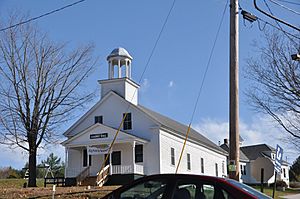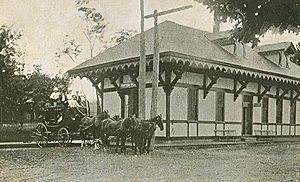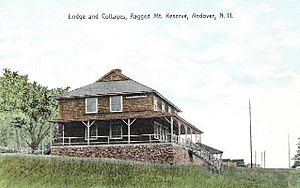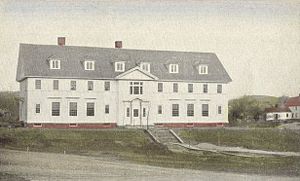Andover, New Hampshire facts for kids
Quick facts for kids
Andover, New Hampshire
|
||
|---|---|---|
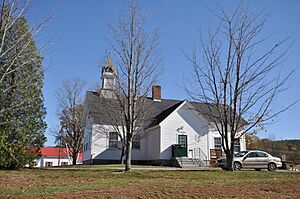
Town hall
|
||
|
||
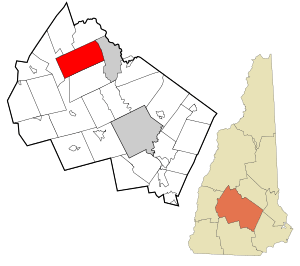
Location in Merrimack County and the state of New Hampshire
|
||
| Country | United States | |
| State | New Hampshire | |
| County | Merrimack | |
| Incorporated | 1779 | |
| Villages |
|
|
| Area | ||
| • Total | 41.0 sq mi (106.3 km2) | |
| • Land | 40.2 sq mi (104.0 km2) | |
| • Water | 0.9 sq mi (2.3 km2) 2.18% | |
| Elevation | 648 ft (198 m) | |
| Population
(2020)
|
||
| • Total | 2,406 | |
| • Density | 60/sq mi (23.1/km2) | |
| Time zone | UTC-5 (Eastern) | |
| • Summer (DST) | UTC-4 (Eastern) | |
| ZIP codes |
03216 (Andover)
03231 (East Andover) |
|
| Area code(s) | 603 | |
| FIPS code | 33-01460 | |
| GNIS feature ID | 0873532 | |
Andover is a small town located in Merrimack County, New Hampshire, in the United States. In 2020, about 2,406 people lived there.
Andover is made up of several smaller areas called villages. These include Cilleyville, Potter Place, East Andover, and West Andover, along with the main town center. The town is also home to Ragged Mountain State Forest. It is also where Proctor Academy, a private school that helps students get ready for college, is located.
Contents
History of Andover
Andover was first settled in 1761. It was originally called "Emerisstown." Before that, in 1746, it was known as "New Breton" or "New Britton." This name came from soldiers who had helped capture Cape Breton Island from the French in 1745.
One of these soldiers was Dr. Anthony Emery. He was a friend of Samuel Phillips Jr., who started Phillips Andover Academy in Andover, Massachusetts. "New Breton" officially became the town of "Andover" in 1779. This was the same year Phillips Andover Academy was finished.
In 1822, a school was opened in Andover, but it closed a few years later in 1828. Another school started in 1848. This school grew into Proctor Academy, which is a very important school for the town's economy today.
Andover is known for its antique shops, beautiful Greek Revival architecture, and two covered bridges. The Potter Place Railroad Station was built in 1874. It is now a museum for the Andover Historical Society and is listed on the National Register of Historic Places.
Geography and Nature
Andover covers a total area of about 106.3 square kilometers (41.0 square miles). Most of this is land, about 104.0 square kilometers (40.2 square miles). The rest, about 2.3 square kilometers (0.9 square miles), is water.
The central and western parts of Andover have the Blackwater River. This river flows into the Contoocook River. The eastern part of town, including Highland Lake, drains into the Pemigewasset River near Franklin. Bradley Lake is in the southern part of Andover. All the water in Andover eventually flows into the Merrimack River.
Ragged Mountain is on the northern edge of Andover. It is about 697 meters (2,286 feet) tall. The southern part of town includes the northern slopes of Mount Kearsarge. The highest point in Andover is on Mount Kearsarge, at about 750 meters (2,460 feet) above sea level.
Andover has several villages: East Andover, West Andover, Cilleyville, and Potter Place. Potter Place is named after Richard Potter. He was an African-American magician who lived there in the early 1800s.
Neighboring Towns
Andover shares its borders with these towns:
- Hill (to the north)
- Franklin (to the east)
- Salisbury (to the south)
- Warner (to the southwest)
- Wilmot (to the west)
- Danbury (to the northwest)
Population Information
| Historical population | |||
|---|---|---|---|
| Census | Pop. | %± | |
| 1790 | 645 | — | |
| 1800 | 1,133 | 75.7% | |
| 1810 | 1,259 | 11.1% | |
| 1820 | 1,642 | 30.4% | |
| 1830 | 1,324 | −19.4% | |
| 1840 | 1,169 | −11.7% | |
| 1850 | 1,220 | 4.4% | |
| 1860 | 1,243 | 1.9% | |
| 1870 | 1,206 | −3.0% | |
| 1880 | 1,204 | −0.2% | |
| 1890 | 1,090 | −9.5% | |
| 1900 | 1,179 | 8.2% | |
| 1910 | 1,201 | 1.9% | |
| 1920 | 1,121 | −6.7% | |
| 1930 | 1,031 | −8.0% | |
| 1940 | 1,108 | 7.5% | |
| 1950 | 1,057 | −4.6% | |
| 1960 | 955 | −9.6% | |
| 1970 | 1,138 | 19.2% | |
| 1980 | 1,587 | 39.5% | |
| 1990 | 1,883 | 18.7% | |
| 2000 | 2,109 | 12.0% | |
| 2010 | 2,371 | 12.4% | |
| 2020 | 2,406 | 1.5% | |
| U.S. Decennial Census | |||
In 2000, there were 2,109 people living in Andover. There were 823 households and 609 families. The population density was about 20 people per square kilometer (52 people per square mile).
About 33.7% of households had children under 18 living with them. Most households (61.7%) were married couples. About 20.5% of households were people living alone.
The population was spread out by age. About 24.3% were under 18 years old. About 12.7% were 65 years or older. The average age in town was 40 years.
Famous People from Andover
- Nahum Josiah Bachelder (1854–1934), who was the 49th governor of New Hampshire.
- Jacob Bailey Moore (1797–1853), a newspaper editor. He also founded and was the first librarian of the New Hampshire Historical Society.
- Richard Potter (1783–1835), a famous magician, hypnotist, and ventriloquist.
Places to Visit
- Potter Place Railroad Station, which also has the Andover Historical Society Museum.
- Northern Rail Trail, a path for walking and biking.
See also
 In Spanish: Andover (Nuevo Hampshire) para niños
In Spanish: Andover (Nuevo Hampshire) para niños


